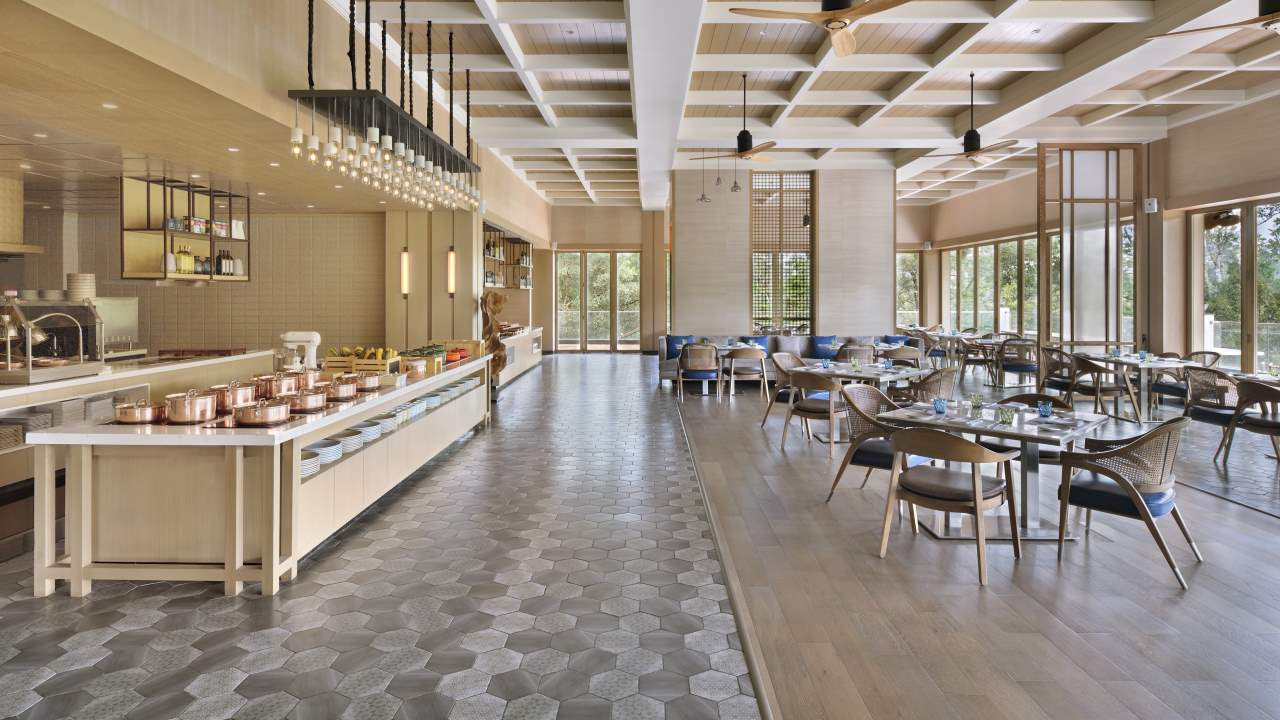Advertisement|Remove ads.
Comfort is the new luxury: Marriott International unveils Asia Pacific’s culinary future
Marriott International’s Future of Food 2026 report reveals a major shift in Asia Pacific’s dining culture, where comfort, authenticity, and emotional connection are redefining luxury. From AI-powered kitchens to locally rooted menus, the future of hospitality is becoming more experiential, sustainable, and storytelling-driven.

In the evolving world of hospitality, the definition of luxury is being rewritten — and it’s no longer about starched linen, silent service, or stiff formality. According to Marriott International’s latest Future of Food 2026 report, indulgence in the Asia Pacific is now defined by comfort, authenticity, and immersive storytelling.
The global hospitality major’s comprehensive new study explores how shifting consumer preferences are reshaping the dining landscape across 20 Asia Pacific markets. The findings are drawn from insights by more than 30 chefs, mixologists, industry insiders, and food media professionals, alongside feedback from Marriott’s F&B teams across 270 properties in the region.
At its core, the report finds that today’s diners are seeking experiences that blend emotional connection with culinary excellence — meals that tell a story, engage the senses, and celebrate local identity.
“The Future of Food 2026 showcases how Asia Pacific continues to shape the future of global dining,” said Petr Raba, Vice President of Food & Beverage, Asia Pacific excluding China, Marriott International. “From the rise of casual luxury to experience-focused dining, today’s guests are seeking emotional connection as much as culinary excellence.”
He added that a new culinary language is emerging across Asia — one where “quality meets comfort, luxury meets experience, and a meal is no longer just about eating, but about engaging all the senses.”
Comfort is the new luxury
The report’s central theme — “Comfort is the New Luxury” — captures a regional pivot from rigid fine dining to what Marriott calls “fine-casual.” Diners increasingly prefer warmth, familiarity, and personality over exclusivity.
Chefs across Asia, from Singapore to Tokyo, are reimagining comfort food with refined creativity — think caviar-topped fried chicken or locally-inspired takes on international favorites. Nearly 59% of Marriott’s surveyed properties report that guests now opt for casual dining over formal experiences, a dramatic shift from pre-pandemic habits.
Menus are becoming more à la carte, allowing diners to personalise their meals and pace, while multi-course tasting menus give way to flexible, time-sensitive formats.
Dining as a sensory journey
Another major trend redefining the region’s F&B scene is the rise of immersive, multisensory dining. Nearly 48% of Marriott’s F&B associates reported an increase in guests seeking interactive experiences — from dining in the dark to edible art presentations or theatrical omakase journeys.
Restaurants are increasingly blending gastronomy with performance, design, and storytelling — blurring the boundaries between hospitality, retail, and entertainment. This “experience economy,” the report suggests, is transforming dining into a form of self-expression and cultural connection.
Rooted in place: Native ingredients take center stage
Authenticity and sustainability are also coming to the fore. The report notes a resurgence in indigenous ingredients and local sourcing as chefs draw inspiration from heritage and the land itself. Eighty-five percent of Marriott’s properties now incorporate local ingredients or dishes, reflecting a strong appetite for seasonality and provenance.
From foraged herbs in Vietnam to heirloom grains in India and artisanal salts in Japan, chefs are reclaiming local produce to create deeper culinary narratives — where each plate tells a story of culture and community.
AI joins the kitchen
Technology, too, is shaping this transformation. As artificial intelligence finds new applications in hospitality, it is driving both efficiency and personalisation.
Seventy-six percent of Marriott’s Asia Pacific properties are already using AI-driven booking and management tools, while 75% note that social media heavily influences guests’ restaurant choices.
Future-facing innovations include AI-powered menu engineering — tools that analyse real-time feedback to optimise dish combinations, pricing, and sustainability. Yet, the report cautions, even as technology automates operations, the essence of hospitality will continue to rest on human connection and creativity.
Asia’s rising culinary capitals
The Future of Food 2026 also spotlights emerging culinary powerhouses. Indonesia, the Philippines, Vietnam, and Mainland China are increasingly recognised as vibrant, globally competitive food destinations.
Their chefs are blending confidence with experimentation, drawing on rich local traditions while embracing contemporary sensibilities. This regional renaissance reflects a growing pride in Asia’s culinary identity — one that’s influencing global dining trends from New York to London.
A new generation of chefs
A new wave of third-generation Asian chefs, many trained in Michelin-starred kitchens abroad, are bringing home innovative techniques while preserving the soul of their native cuisines.
They are redefining what it means to cook Asian food — combining technique with emotion, nostalgia with novelty. Street food entrepreneurs, or “hawkerpreneurs,” are part of this creative wave too, giving a luxe spin to local staples like laksa or satay.
“They’re not just cooking; they’re preserving heritage while charting a new course,” the report notes. “Tradition and innovation can coexist harmoniously on the plate.”
Beyond the plate: Bars, wellness, and sustainability
Marriott’s findings extend beyond kitchens to bar counters and community tables. Across Asia, cocktail culture is undergoing its own reinvention — led by low- and no-alcohol drinks, omakase-style cocktail experiences, and beverages infused with native ingredients.
Guests, particularly younger consumers, are prioritising wellness and personalisation over indulgence for its own sake.
Meanwhile, sustainability is taking center stage as local chefs and social enterprises champion biodiversity, empower small farmers, and revive lost ingredients — signaling a cultural shift that could redefine the region’s broader food ecosystem.
The future is emotional, experiential, and local
In essence, The Future of Food 2026 paints a picture of an industry in transformation — where comfort, emotion, and connection are the new benchmarks of luxury.
As Petr Raba summarised: “Food is no longer just fuel; it’s storytelling, identity, and cultural connection.”
And in Asia Pacific — the world’s most dynamic culinary laboratory — that story is only just beginning to unfold.
Also Read: FHRAI seeks GST relief for hospitality sector; calls for regularisation of past dues, restoration of ITC, and delinking of F&B rates from room tariffs
The global hospitality major’s comprehensive new study explores how shifting consumer preferences are reshaping the dining landscape across 20 Asia Pacific markets. The findings are drawn from insights by more than 30 chefs, mixologists, industry insiders, and food media professionals, alongside feedback from Marriott’s F&B teams across 270 properties in the region.
At its core, the report finds that today’s diners are seeking experiences that blend emotional connection with culinary excellence — meals that tell a story, engage the senses, and celebrate local identity.
“The Future of Food 2026 showcases how Asia Pacific continues to shape the future of global dining,” said Petr Raba, Vice President of Food & Beverage, Asia Pacific excluding China, Marriott International. “From the rise of casual luxury to experience-focused dining, today’s guests are seeking emotional connection as much as culinary excellence.”
He added that a new culinary language is emerging across Asia — one where “quality meets comfort, luxury meets experience, and a meal is no longer just about eating, but about engaging all the senses.”
Comfort is the new luxury
The report’s central theme — “Comfort is the New Luxury” — captures a regional pivot from rigid fine dining to what Marriott calls “fine-casual.” Diners increasingly prefer warmth, familiarity, and personality over exclusivity.
Chefs across Asia, from Singapore to Tokyo, are reimagining comfort food with refined creativity — think caviar-topped fried chicken or locally-inspired takes on international favorites. Nearly 59% of Marriott’s surveyed properties report that guests now opt for casual dining over formal experiences, a dramatic shift from pre-pandemic habits.
Menus are becoming more à la carte, allowing diners to personalise their meals and pace, while multi-course tasting menus give way to flexible, time-sensitive formats.
Dining as a sensory journey
Another major trend redefining the region’s F&B scene is the rise of immersive, multisensory dining. Nearly 48% of Marriott’s F&B associates reported an increase in guests seeking interactive experiences — from dining in the dark to edible art presentations or theatrical omakase journeys.
Restaurants are increasingly blending gastronomy with performance, design, and storytelling — blurring the boundaries between hospitality, retail, and entertainment. This “experience economy,” the report suggests, is transforming dining into a form of self-expression and cultural connection.
Rooted in place: Native ingredients take center stage
Authenticity and sustainability are also coming to the fore. The report notes a resurgence in indigenous ingredients and local sourcing as chefs draw inspiration from heritage and the land itself. Eighty-five percent of Marriott’s properties now incorporate local ingredients or dishes, reflecting a strong appetite for seasonality and provenance.
From foraged herbs in Vietnam to heirloom grains in India and artisanal salts in Japan, chefs are reclaiming local produce to create deeper culinary narratives — where each plate tells a story of culture and community.
AI joins the kitchen
Technology, too, is shaping this transformation. As artificial intelligence finds new applications in hospitality, it is driving both efficiency and personalisation.
Seventy-six percent of Marriott’s Asia Pacific properties are already using AI-driven booking and management tools, while 75% note that social media heavily influences guests’ restaurant choices.
Future-facing innovations include AI-powered menu engineering — tools that analyse real-time feedback to optimise dish combinations, pricing, and sustainability. Yet, the report cautions, even as technology automates operations, the essence of hospitality will continue to rest on human connection and creativity.
Asia’s rising culinary capitals
The Future of Food 2026 also spotlights emerging culinary powerhouses. Indonesia, the Philippines, Vietnam, and Mainland China are increasingly recognised as vibrant, globally competitive food destinations.
Their chefs are blending confidence with experimentation, drawing on rich local traditions while embracing contemporary sensibilities. This regional renaissance reflects a growing pride in Asia’s culinary identity — one that’s influencing global dining trends from New York to London.
A new generation of chefs
A new wave of third-generation Asian chefs, many trained in Michelin-starred kitchens abroad, are bringing home innovative techniques while preserving the soul of their native cuisines.
They are redefining what it means to cook Asian food — combining technique with emotion, nostalgia with novelty. Street food entrepreneurs, or “hawkerpreneurs,” are part of this creative wave too, giving a luxe spin to local staples like laksa or satay.
“They’re not just cooking; they’re preserving heritage while charting a new course,” the report notes. “Tradition and innovation can coexist harmoniously on the plate.”
Beyond the plate: Bars, wellness, and sustainability
Marriott’s findings extend beyond kitchens to bar counters and community tables. Across Asia, cocktail culture is undergoing its own reinvention — led by low- and no-alcohol drinks, omakase-style cocktail experiences, and beverages infused with native ingredients.
Guests, particularly younger consumers, are prioritising wellness and personalisation over indulgence for its own sake.
Meanwhile, sustainability is taking center stage as local chefs and social enterprises champion biodiversity, empower small farmers, and revive lost ingredients — signaling a cultural shift that could redefine the region’s broader food ecosystem.
The future is emotional, experiential, and local
In essence, The Future of Food 2026 paints a picture of an industry in transformation — where comfort, emotion, and connection are the new benchmarks of luxury.
As Petr Raba summarised: “Food is no longer just fuel; it’s storytelling, identity, and cultural connection.”
And in Asia Pacific — the world’s most dynamic culinary laboratory — that story is only just beginning to unfold.
Also Read: FHRAI seeks GST relief for hospitality sector; calls for regularisation of past dues, restoration of ITC, and delinking of F&B rates from room tariffs
Read about our editorial guidelines and ethics policy

/filters:format(webp)https://images.cnbctv18.com/uploads/2024/05/hcltech-2024-05-9dff5a2f40144528559b0cc977ec0006.jpg)
/filters:format(webp)https://st-everywhere-cms-prod.s3.us-east-1.amazonaws.com/cnbctv18logo.png)
/filters:format(webp)https://news.stocktwits-cdn.com/large_Getty_Images_1156576940_jpg_70ab3f2a1c.webp)
/filters:format(webp)https://st-everywhere-cms-prod.s3.us-east-1.amazonaws.com/unnamed_jpg_9dff551b50.webp)
/filters:format(webp)https://news.stocktwits-cdn.com/large_Getty_Images_2232147678_jpg_9e7c3ea177.webp)
/filters:format(webp)https://news.stocktwits-cdn.com/shivani_photo_jpg_dd6e01afa4.webp)
/filters:format(webp)https://news.stocktwits-cdn.com/astspacemobile_resized_jpg_8a6aa92413.webp)
/filters:format(webp)https://news.stocktwits-cdn.com/IMG_4530_jpeg_a09abb56e6.webp)
/filters:format(webp)https://images.cnbctv18.com/uploads/2025/01/akzo-nobel-2025-01-876115eee926f1950f24567b5e08e8e0.jpeg)
/filters:format(webp)https://images.cnbctv18.com/uploads/2024/01/coorg-marriott.jpg)